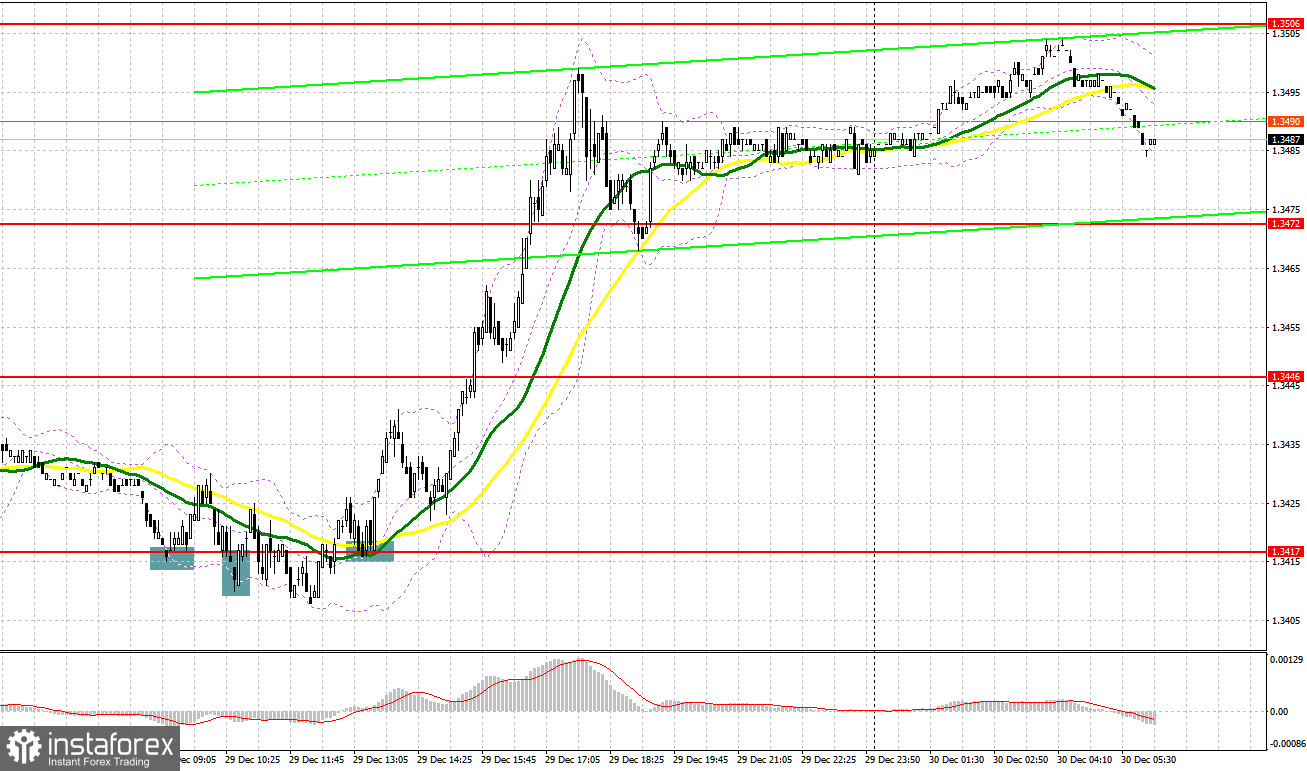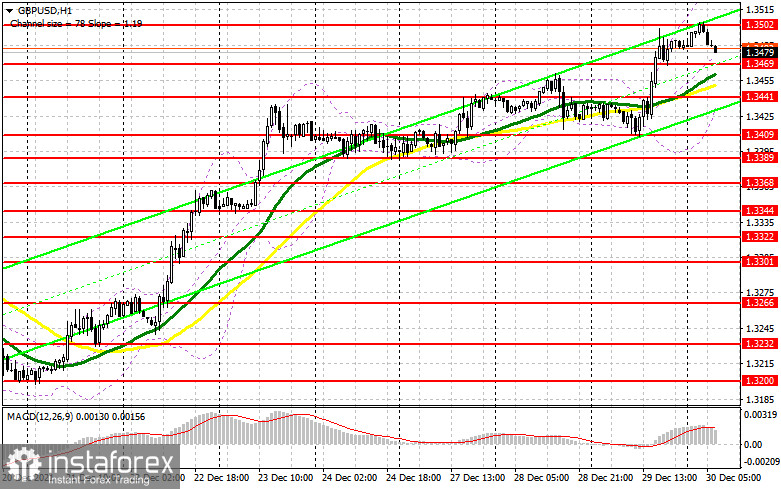To open long positions on GBP/USD, you need:
Several excellent signals to buy the British pound were formed yesterday. Let's take a look at the 5 minute chart and understand the entry points. In my morning forecast, I paid attention to the 1.3417 level and advised you to make decisions on entering the market. Failure to surpass this range led to forming an excellent signal to open long positions. However, the first wave of growth showed a movement of only 15 points, after which the pressure on the pair returned. The second false breakout of this range did not lead to an increase in the pair at all. This made one think about selling after breaking below 1.3417. However, a return of GBP/USD back to 1.3417 and a reverse test of this level from top to bottom in the afternoon - all this led to forming another good entry point into long positions. As a result, it was possible to observe the growth of the pound by more than 80 points.

At the end of the year, low trading volume leads to excessive volatility in the pair, so don't be surprised if the bullish trend continues today. Larger moves are expected during the US session, when a number of reports on the US economy are released. Considering how high the pound has climbed, the bulls' first priority for today is to protect the new support at 1.3469. This level is very important, as its breakdown could force traders to take profits from December highs at the end of the year, which will lead to forming pressure on the pound. There are moving averages that play on the bulls' side below this range. Forming a false breakout at 1.3469 generates a signal to buy GBP/USD with the prospect of continuing the bull market, with the goal of surpassing the 35th figure base, which we stumbled over yesterday. A breakdown and test of this level from top to bottom will provide an additional entry point and strengthen the bulls' positions in order to continue building a bullish trend and renew highs: 1.3525 and 1.3567. The 1.3605 level is a more distant target, where I recommend taking profits. In case the pound falls during the European session and lack of activity at 1.3469, it is best to postpone buying to the level of 1.3441. Forming a false breakout there will provide an entry point, counting on the preservation of the bullish momentum. It is possible to buy GBP/USD immediately on a rebound from 1.3409, or even lower - from a 1.3389 low, counting on a correction of 20-25 points within the day.
To open short positions on GBP/USD, you need:
The bears failed to offer anything below 1.3417, missing out on their chance to regain control of the market. Now you need to think about something around 1.3502. Protecting this range will be of paramount concern. Forming a false breakout at this level creates the first entry point into short positions with a subsequent decline to the 1.3469 area, which will have to be fought for, since the bulls clearly do not intend to release the upward trend at the end of the year. A breakdown of 1.3469 and a reverse test from the bottom up will increase the pressure on the pound and bring it down to the next support at 1.3441. Only the consolidation and the reverse test of 1.3441 from the bottom up can provide a new entry point into short positions with the prospect of a decline in GBP/USD to 1.3409 and 1.3389, where I recommend taking profits. In case the pair grows during the European session and the bears are not active at 1.3502, it is best to postpone selling until the larger resistance at 1.3525. I also recommend opening short positions there only in case of a false breakout. Selling GBP/USD immediately on a rebound is possible from a large resistance at 1.3567, or even higher - from a new high in the 1.3605 area, counting on the pair's rebound down by 20-25 points within the day.

I recommend for review:
The Commitment of Traders (COT) report for December 21 revealed that there was a decline in both short and long positions. The number of long positions has shrunk much more, which has increased the negative value of the delta. Traders have already priced in the Fed and BoE meetings. However, the pound sterling decreased sharply after a rally fueled by an interest rate hike. Only a week later, and we do not have these data yet, the British currency managed to recoup all the losses and reached the December highs. Therefore, I do not recommend taking the current report seriously as it does not reflect the real situation in the market. If you look at the overall picture, the prospects for the British currency are bright. Traders continue to open long positions on the pound sterling following the Bank of England's decision to raise the benchmark rate. A more aggressive stance of the regulator next year will certainly strengthen the bullish trend for the GBP/USD pair. High inflation remains the main reason why the Bank of England may hike the interest rate again. The US dollar may also gain momentum as the Fed plans to raise the key rate in the spring of next year, which makes the US dollar a more attractive asset. The COT report for December 21 showed that the number of long non-commercial positions fell 20,824 from 29,497, while the number of short non-commercial positions declined to 78,510 from 80,245. This led to an increase in the negative non-commercial net position to -57,686 from -50,748. The weekly closing price has hardly changed: 1.3209 versus 1.3213 a week earlier.
Indicator signals:
Trading is carried out above 30 and 50 moving averages, which indicates the continued growth of the pound in the short term.
Moving averages
Note: The period and prices of moving averages are considered by the author on the H1 hourly chart and differs from the general definition of the classic daily moving averages on the daily D1 chart.
Bollinger Bands
If the pair falls, the lower border of the indicator at 1.3441 will act as a support. If the pair grows, the upper border of the indicator at 1.3515 will act as a resistance.
Description of indicators
- Moving average (moving average, determines the current trend by smoothing out volatility and noise). Period 50. It is marked in yellow on the chart.
- Moving average (moving average, determines the current trend by smoothing out volatility and noise). Period 30. It is marked in green on the chart.
- MACD indicator (Moving Average Convergence/Divergence — convergence/divergence of moving averages) Quick EMA period 12. Slow EMA period to 26. SMA period 9
- Bollinger Bands (Bollinger Bands). Period 20
- Non-commercial speculative traders, such as individual traders, hedge funds, and large institutions that use the futures market for speculative purposes and meet certain requirements.
- Long non-commercial positions represent the total long open position of non-commercial traders.
- Short non-commercial positions represent the total short open position of non-commercial traders.
- Total non-commercial net position is the difference between short and long positions of non-commercial traders.





















